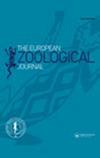The echinoderm innate humoral immune response
引用次数: 20
Abstract
Abstract Multicellular organisms have an immune system, which is essential for the survival of living beings. Interest in the immune system has been expanded since common characteristics of innate immunity between Drosophila melanogaster (Meigen, 1830) and mammals were discovered in the 1980. Since then, immunology has mainly focused on the adaptive immune system that seems to be restricted to vertebrates. Unlike the innate immunity, the adaptive one is acquired after exposure to a specific antigen (Ag) and includes: antigen-presenting cells such as macrophages, proliferation of B and T lymphocytes, Ag-specific antibody/cytokine production and immunological memory. Innate immunity is instead a process of cellular defense at low specificity, which is designed to prevent and combat infectious agents that penetrate at the tissue level, and may be the only form of immunity present in invertebrates such as sea urchins. The immune system of invertebrates acts through (i) cellular components (cell-mediated immunity) in which the effectors of defense reactions are represented by immune cells; (ii) soluble factors (humoral immunity), secreted by the immune cells, such as lectins, agglutinins, lysins, antimicrobial peptides and the prophenoloxidase (proPO) activating system, which act in parallel with the immune cells to fight pathogens and other foreign substances. Here we aim to deepen the study on humoral immunity of invertebrates, especially referring to the phylum Echinodermata because of its features shared with protostomes and other deuterostomes, and suggesting a key step during evolution.棘皮动物的先天体液免疫反应
多细胞生物具有免疫系统,这对生物的生存至关重要。自20世纪80年代发现黑腹果蝇(Meigen, 1830)和哺乳动物先天免疫的共同特征以来,对免疫系统的兴趣已经扩大。从那时起,免疫学主要关注似乎仅限于脊椎动物的适应性免疫系统。与先天免疫不同,适应性免疫是在暴露于特定抗原(Ag)后获得的,包括抗原呈递细胞如巨噬细胞、B淋巴细胞和T淋巴细胞的增殖、Ag特异性抗体/细胞因子的产生和免疫记忆。相反,先天免疫是一种低特异性的细胞防御过程,旨在预防和对抗穿透组织水平的感染因子,这可能是海胆等无脊椎动物中存在的唯一免疫形式。无脊椎动物的免疫系统通过(i)细胞成分(细胞介导的免疫)起作用,其中防御反应的效应器由免疫细胞代表;(ii)由免疫细胞分泌的可溶性因子(体液免疫),如凝集素、凝集素、溶素、抗菌肽和酚氧化酶原(proPO)激活系统,它们与免疫细胞并行作用,对抗病原体和其他外来物质。在这里,我们的目的是深化对无脊椎动物体液免疫的研究,特别是指棘皮动物门,因为它与原口动物和其他后口动物有共同的特征,并提出了进化的关键步骤。
本文章由计算机程序翻译,如有差异,请以英文原文为准。
求助全文
约1分钟内获得全文
求助全文

 求助内容:
求助内容: 应助结果提醒方式:
应助结果提醒方式:


